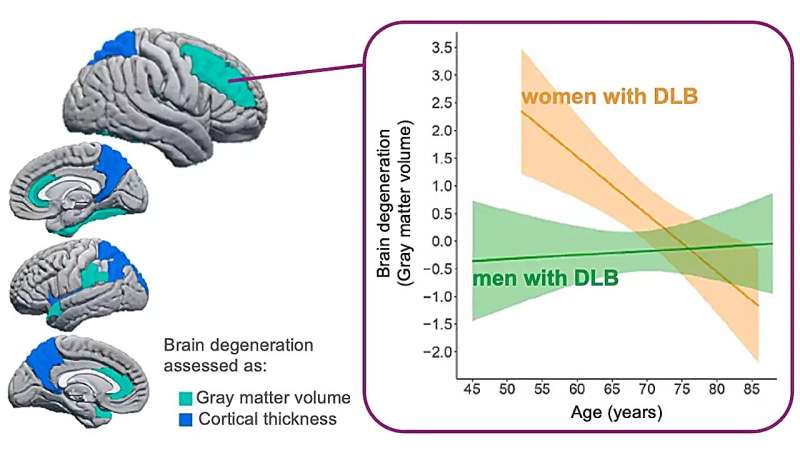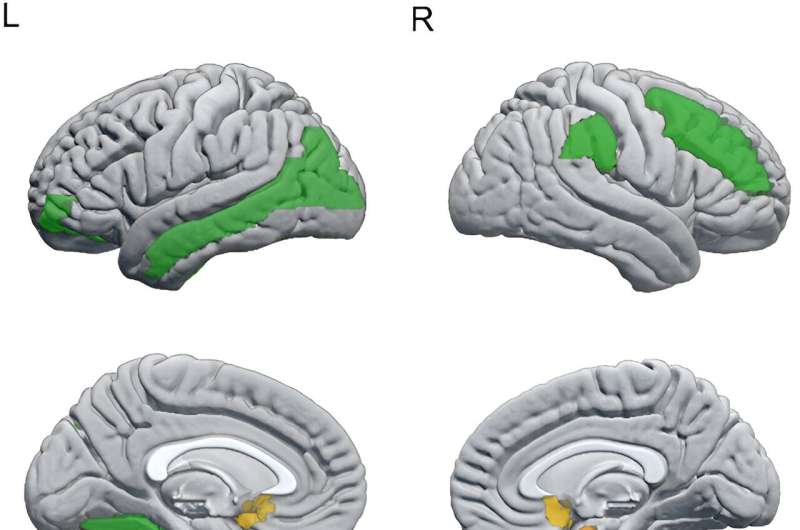This article has been reviewed according to Science X's editorial process and policies. Editors have highlighted the following attributes while ensuring the content's credibility:
fact-checked
peer-reviewed publication
trusted source
proofread
A type of dementia that hits the brains of men and women differently

Dementia is a brain disease that affects mental capacities such as the individual's memory, language, or capacity to understand and deal with emotions. Among the different types of dementia, dementia with Lewy bodies (DLB) is a relatively frequent dementia.
Recently, there has been an interest in understanding better whether sex and gender play a role in DLB. Two recent publications from researchers at Karolinska Institutet address this question on sex differences in DLB.
Sex differences in dementia with Lewy bodies
Dementia care is moving away from treating all patients with the same approach. Instead, the individual characteristics of patients, for example, their sex, age, lifestyle, or previous personal history, influence how dementia is detected and treated. This individualized approach is particularly important in diseases that are very differently expressed across patients, like dementia with Lewy bodies (DLB).
For many years, it has been known that sex must have an important role in DLB, since there are many more men than women with DLB. However, the reasons for this finding are not fully understood.
Recent research has helped to clarify that, for example, men and women with DLB show different symptoms. While men with DLB are more likely to experience disturbances in their dream sleep and movement problems, women with DLB tend to experience more visual hallucinations.
Last December 2023, Dr. Javier Oltra and colleagues in the Ferreira lab published a study that has helped advance our understanding of how the disease affects the brains of men and women with DLB. Drs. Oltra, Habich, Ferreira and colleagues led a large international collaboration between researchers at the Karolinska Institute, the University of Barcelona, the European DLB consortium, and the Mayo Clinic in Rochester, U.S., in part facilitated by the Mayo Clinic and Karolinska Institutet Collaboration.
Together, the researchers posed the question of how a patient's sex affects brain matter loss in DLB. The results of this investigation were published in Alzheimer's and Dementia.
To answer the question, Dr. Oltra, Habich, Ferreira and colleagues analyzed the world's largest DLB imaging dataset which includes data from 442 patients from 14 centers across Europe and the Mayo Clinic in the U.S.
The researchers applied two different methods to define brain matter loss. For the first method, a specialized medical doctor visually inspected images of the brain and judged whether brain matter loss occurs in large areas of the brain.

That method is simple but relevant since it is the approach applied in clinical routine today, thus facilitating the translation of findings from the research to the clinic. The second method used an advanced and automated procedure to assess the loss of brain matter in smaller brain regions.
The study revealed that men with DLB lose more brain matter than women with DLB across many brain regions, but particularly in regions at the front of the brain (frontal lobe). Interestingly, these sex differences were more prominent at younger ages of patients and decreased at older ages, with differences between women and men with DLB disappearing around the age of 75 years.
The researchers also showed that the regional loss of brain matter in men was associated with cognitive problems and the presence of visual hallucinations.
Ongoing studies
Building on these sex differences in brain loss in DLB, the team conducted a second study (available on Research Square) led by Dr. Annegret Habich, this time using a network point of view.
The network approach allows us to investigate complex patterns of brain matter loss that emerge across multiple brain regions instead of focusing on one brain region at a time. This is important as the disease underlying DLB, the so-called Lewy body disease, is assumed to induce the loss of brain matter and propagate across the brain along these brain networks, instead of being confined to one brain region.
Their study showed that the sex differences in brain networks mainly arose between healthy women and healthy men, but the sex differences were diluted in patients with DLB.
In line with the previous study, these findings highlight the importance of sex in DLB, and could explain why the disease propagates across the brain differently in men and women until sex differences disappear at the dementia stage of the disease.
Overall, the findings of these two studies suggest that the loss of brain matter starts earlier in men with DLB. In contrast, the loss of brain matter in women with DLB starts later but follows a more aggressive course.
Therefore, while women and men with DLB ultimately reach similar levels in the severity of the disease, their respective disease processes may differ drastically.
Raising awareness of this issue will help clinicians detect the disease earlier and more accurately in women and men with DLB, which is the first step towards providing patients with adequate dementia care and treatment options.
More information: Javier Oltra et al, Sex differences in brain atrophy in dementia with Lewy bodies, Alzheimer's & Dementia (2023). DOI: 10.1002/alz.13571
Annegret Habich et al, Sex differences in grey matter networks in dementia with Lewy bodies, Research Square (2023). DOI: 10.21203/rs.3.rs-2519935/v1





















